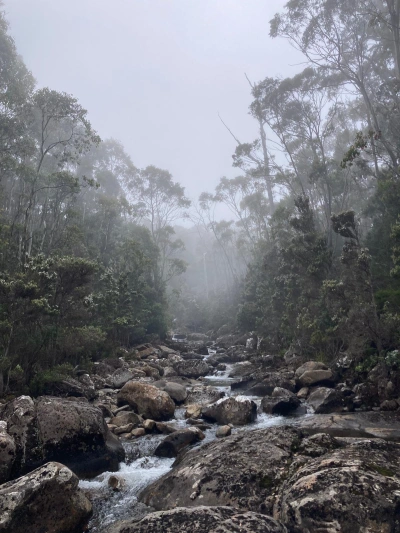Mountain Reverence
Kunanyi - Mount Wellington
There are many who perceive the mountain as a being, casting its shadow over us. It can be quite prosaic, as lightly coloured as a stage set before the scene changes, the mountain goes dark and the lookout gets lost in the stars. Or joyous, on those mornings when the mountain is a festival of brilliance, glowing in burnished orange, flooding the day ahead. And sometimes, on occasion, it has been observed that the mountain isn’t there at all.
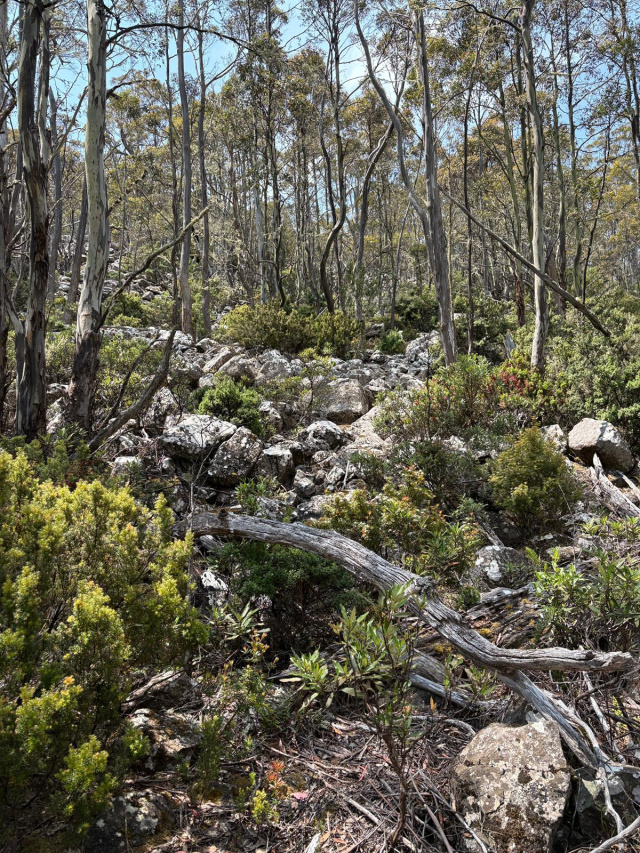
I arrived in Hobart at night, under the cover of darkness. I was quite young and walked off the plane to catch the airport bus to the youth hostel. The next day I was so surprised to wake up and find the mountain here.
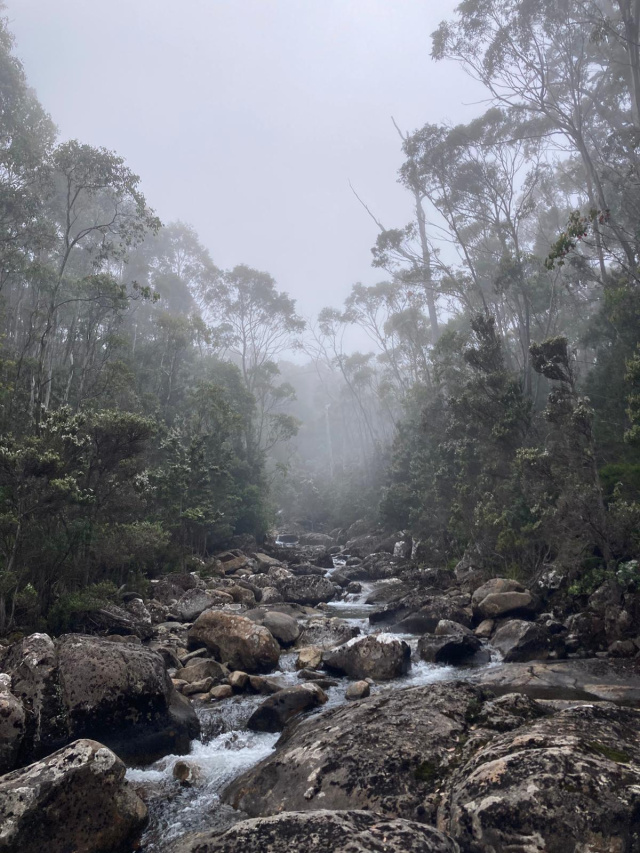
There are times when the cloud lowers and the mountain becomes hypothetical; and living here is delightful, nesting in clouds. When it snows, and the cloud lifts, and the sun shines, the top of kunanyi is embossed with a brilliant glossy white. In previous decades this was more frequent, with the chill of the winter air measured by the icy lengths of white running down its slopes. One day last year, having been in Melbourne for the weekend, I arrived home to find a grey goshawk sitting in the big eucalypt in our backyard, where it stayed for half an hour. I was mesmerised, the experience felt like a visitation, I had been the beneficiary of something sacred.
This past summer I was walking at dawn along the O’Grady’s Falls track and glanced into the bush to see a face, its eyes fixed upon me. With a slight shock, thinking I’d caught the gaze of a feral cat, I peered into the trees and saw a Tawny Frogmouth chick, and its family, nestled together low to the ground, looking back.
A week or so later, I saw the tawny chick again, not far from its roost. It was sitting in a branch above the track watching me, and when it realised it was observed, it quickly assumed the branch position. I’ve seen tawnies through the years, and have always loved them, but never before have I had the experience of looking directly into one’s face as I did with this one. On resuming my walk, I rounded the corner and a boobook flew across the track, alighting a tree ahead.
Depending on the time of day and the weather, you can hear in these surrounds the bush music composers have been trying to transcribe for decades. The bell-like calls of the bronze-winged cuckoo mixed in with the gentle hoot of tawny frogmouths, against the cacophony of kookaburras and cockatoos, chuckling wattlebirds and the melodic thoughts of currawongs, forming a symphony together. At times the whole valley is filled with reverberation, a soundscape describing the lay of the land, the listener contained within.

Our senses are dimmed and we are accustomed to tuning out the hum of cars rising like smoke from the city, as we passively accept our surroundings, which is easy when you can't remember it any other way. But imagine the terror of waking into this century from nearly all other times to hear the world itself as a machine, caught in continuous lines of rumbling pitches threading from here to the horizon.
In the 1985 book ‘Lake Pedder’, local Tasmanian writer and geologist, Kevin Kiernan, wrote a heartbreaking piece documenting the campaign to save Lake Pedder called “I Saw My Temple Ransacked”. In his introduction, as he mulls over what wilderness means to him, he sets the scene, by writing:
“I had grown up in Hobart's bushland suburb of Fern Tree where Mt Wellington, which rises behind the city, had been my backyard. At about this time I could draw a wide arc on the map from the summit of the mountain westwards one hundred kilometres to the coast without crossing a road. The wilderness seemed to start in my backyard.”
This is an extraordinary feeling and, even with the changes of the intervening years, his description is evocative of standing at the top of the mountain watching wild stretches of rippling blue fading to the beyond.
In his piece, Kevin talks about the sense of the sacred that we experience within the grandeur of wild places, and the emotions that arise within us which are not limited by our everyday lives and thoughts, but expand into feeling-ness; for him, this was the strong sense of belonging he experienced on the shores of Lake Pedder.
Closer to home, I feel like this is how each of us is drawn into a relationship with kunanyi.
I’ve been at O’Grady’s Falls when a platypus has come out of the rockpool underneath the bridge and climbed up the steep path on the left-hand side to continue over the top of the falls, heading upstream.
Recently, I was startled by a lyrebird tearing across the path at the beginning of the O’Grady’s Falls track. It was running downhill at a pace and as it careered across the road, in that instant, the dogs and I had exactly the same impulse, we wanted to chase.
Our family arrives home with news reports of glimpsed tiger snakes, or where an owl is perching, or photos of echidnas to share and whether the yellow-tailed blacks are predicting rain. When the light is dim, microbats flitter in your peripheral vision, only just bigger than moths.
And more than once on a blue sky day, we have been roused by a sudden yell to rush out of the house and find our son pointing to the sky, where, craning our necks, we’ve watched wedge-tailed eagles circling in the air streams above.
With the season change, boobooks have been calling to each other as they've neared the end of their trek through the trees at dawn.
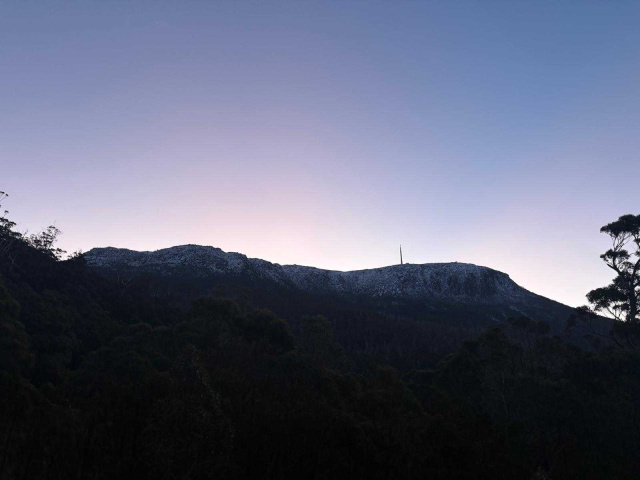
In the arguments we create as we search to articulate why we need to protect wild places, there is this uncomfortable sense of being trapped in a hall of mirrors: you wonder if the only way to protect a wild place and other species, is to argue for the benefit that is gained by humans; we are hopeless when it comes to interests other than our own.
Yet in nature, we assume a smaller and more normal size in relation to the rest of the world, and we take up less space as we perceive other beings. When immersed in the world of the senses, the creatures of the bush appear; and with our reverence this treasure, and the mountain, will stay.
There are many who perceive the mountain as a being, casting its shadow over us. It can be quite prosaic, as lightly coloured as a stage set before the scene changes, the mountain goes dark and the lookout gets lost in the stars. Or joyous, on those mornings when the mountain is a festival of brilliance, glowing in burnished orange, flooding the day ahead. And sometimes, on occasion, it has been observed that the mountain isn’t there at all.

I arrived in Hobart at night, under the cover of darkness. I was quite young and walked off the plane to catch the airport bus to the youth hostel. The next day I was so surprised to wake up and find the mountain here.

There are times when the cloud lowers and the mountain becomes hypothetical; and living here is delightful, nesting in clouds. When it snows, and the cloud lifts, and the sun shines, the top of kunanyi is embossed with a brilliant glossy white. In previous decades this was more frequent, with the chill of the winter air measured by the icy lengths of white running down its slopes. One day last year, having been in Melbourne for the weekend, I arrived home to find a grey goshawk sitting in the big eucalypt in our backyard, where it stayed for half an hour. I was mesmerised, the experience felt like a visitation, I had been the beneficiary of something sacred.
This past summer I was walking at dawn along the O’Grady’s Falls track and glanced into the bush to see a face, its eyes fixed upon me. With a slight shock, thinking I’d caught the gaze of a feral cat, I peered into the trees and saw a Tawny Frogmouth chick, and its family, nestled together low to the ground, looking back.
A week or so later, I saw the tawny chick again, not far from its roost. It was sitting in a branch above the track watching me, and when it realised it was observed, it quickly assumed the branch position. I’ve seen tawnies through the years, and have always loved them, but never before have I had the experience of looking directly into one’s face as I did with this one. On resuming my walk, I rounded the corner and a boobook flew across the track, alighting a tree ahead.
Depending on the time of day and the weather, you can hear in these surrounds the bush music composers have been trying to transcribe for decades. The bell-like calls of the bronze-winged cuckoo mixed in with the gentle hoot of tawny frogmouths, against the cacophony of kookaburras and cockatoos, chuckling wattlebirds and the melodic thoughts of currawongs, forming a symphony together. At times the whole valley is filled with reverberation, a soundscape describing the lay of the land, the listener contained within.

Our senses are dimmed and we are accustomed to tuning out the hum of cars rising like smoke from the city, as we passively accept our surroundings, which is easy when you can't remember it any other way. But imagine the terror of waking into this century from nearly all other times to hear the world itself as a machine, caught in continuous lines of rumbling pitches threading from here to the horizon.
In the 1985 book ‘Lake Pedder’, local Tasmanian writer and geologist, Kevin Kiernan, wrote a heartbreaking piece documenting the campaign to save Lake Pedder called “I Saw My Temple Ransacked”. In his introduction, as he mulls over what wilderness means to him, he sets the scene, by writing:
“I had grown up in Hobart's bushland suburb of Fern Tree where Mt Wellington, which rises behind the city, had been my backyard. At about this time I could draw a wide arc on the map from the summit of the mountain westwards one hundred kilometres to the coast without crossing a road. The wilderness seemed to start in my backyard.”
This is an extraordinary feeling and, even with the changes of the intervening years, his description is evocative of standing at the top of the mountain watching wild stretches of rippling blue fading to the beyond.
In his piece, Kevin talks about the sense of the sacred that we experience within the grandeur of wild places, and the emotions that arise within us which are not limited by our everyday lives and thoughts, but expand into feeling-ness; for him, this was the strong sense of belonging he experienced on the shores of Lake Pedder.
Closer to home, I feel like this is how each of us is drawn into a relationship with kunanyi.
I’ve been at O’Grady’s Falls when a platypus has come out of the rockpool underneath the bridge and climbed up the steep path on the left-hand side to continue over the top of the falls, heading upstream.
Recently, I was startled by a lyrebird tearing across the path at the beginning of the O’Grady’s Falls track. It was running downhill at a pace and as it careered across the road, in that instant, the dogs and I had exactly the same impulse, we wanted to chase.
Our family arrives home with news reports of glimpsed tiger snakes, or where an owl is perching, or photos of echidnas to share and whether the yellow-tailed blacks are predicting rain. When the light is dim, microbats flitter in your peripheral vision, only just bigger than moths.
And more than once on a blue sky day, we have been roused by a sudden yell to rush out of the house and find our son pointing to the sky, where, craning our necks, we’ve watched wedge-tailed eagles circling in the air streams above.
With the season change, boobooks have been calling to each other as they've neared the end of their trek through the trees at dawn.

In the arguments we create as we search to articulate why we need to protect wild places, there is this uncomfortable sense of being trapped in a hall of mirrors: you wonder if the only way to protect a wild place and other species, is to argue for the benefit that is gained by humans; we are hopeless when it comes to interests other than our own.
Yet in nature, we assume a smaller and more normal size in relation to the rest of the world, and we take up less space as we perceive other beings. When immersed in the world of the senses, the creatures of the bush appear; and with our reverence this treasure, and the mountain, will stay.
You might like...
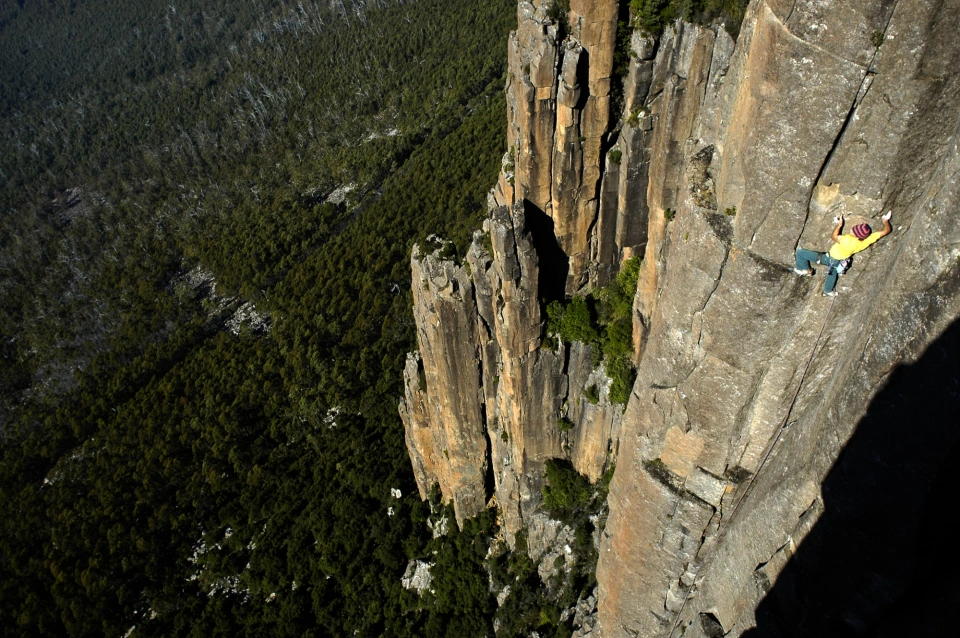
On the Shoulders of Giants Some thoughts on climbing on the Organ Pipes, Kunanyi

Re-wilding the New Town Rivulet

A precious mountain refuge for birdlife

A clarion call for species close to brink of extinction
Newsletter
Sign up to keep in touch with articles, updates, events or news from Kuno, your platform for nature

